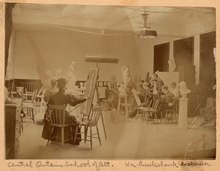William Cruikshank (painter)
William Cruikshank | |
|---|---|
 | |
| Born | 1848/9 |
| Died | 1922 (aged 72 or 73) |
| Nationality | Scots Canadian |
| Alma mater | |
| Known for | Painter |
| Elected | Associate Royal Canadian Academy of Arts |
William Cruikshank (1848/9 – 1922)
Career

In 1871, Cruikshank settled in
In 1884 he was elected an associate member of the
Cruikshank and Tom Thomson
It has been suggested that around 1906 or 1907, Tom Thomson took private lessons from Cruikshank at the Ontario College of Art and Design.[12] Only two sources corroborate this however. The first is a single undated note from Cruikshank to professor James Mavor, arranging to bring a "Tomson" [sic] to meet him.[13] Further complicating the matter is that the original class list no longer survives.[14] The second is a letter from H. B. Jackson to Blodwen Davies, writing, "Tom studied from life & the antique in art school. If I remember right Cruikshank was the instructor."[15] Cruikshank was likely Thomson's only art instructor in an art school.[16]
There also are indications in Thomson`s early work that suggest Cruikshank may have been his teacher. Thomson's painting, reputed to be his first oil, Young Man with a Team of Horses, though modest, is said to have caused Cruikshank to tell him, he'd better "keep on".[11] The theme of ploughing Thomson used is found in Cruikshank's Ploughing, Lower St. Lawrence and may indicate Thomson knew the work of Cruikshank.[11] Also, if Thomson had Cruikshank as a teacher, he would have been encouraged by his instructor to carry a pocket sketchbook and obtain constant practice in drawing, and Thomson did fill such sketchbooks with drawings c. 1906.[17]
Gallery
-
Bullfinch, 1861–97. Boston Public Library
-
Linnet, 1861–97. Boston Public Library
-
Breaking a Road, 1894. National Gallery of Canada, Ottawa
-
Sand Wagon, 1895. National Gallery of Canada, Ottawa
References
Notes
- ^ The National Gallery of Canada provides birth and death dates of 25 December 1848 and 19 May 1922, respectively.[1] Robert Stacey and Dennis Reid instead simply provide the years 1849 and 1922.[2][3] The National Gallery of Canada further provides his birthplace as Broughty Ferry, Scotland and his death place as Kansas City, Missouri.[1]
Citations
- ^ a b "William Cruikshank". www.gallery.ca. National Gallery of Canada. Retrieved 4 October 2018.
- ^ a b Stacey (2002), p. 52.
- ^ Reid (2002), p. 70.
- ^ Bradfield 1970, p. n.p..
- ^ Murray (1986), p. 6.
- ^ Reid (2002), p. 69–70.
- ^ Stacey (2002), pp. 52–53.
- ^ MacDonald (1926), quoted in Reid (2002), p. 74.
- ^ "Members since 1880". Royal Canadian Academy of Arts. Archived from the original on 26 May 2011. Retrieved 11 September 2013.
- ^ "William Cruikshank fonds". www.gallery.ca. National Gallery of Canada. Retrieved 20 November 2023.
- ^ a b c Murray 1998, p. 38.
- ^
- Hill (2002), p. 113
- Murray (1986), p. 6
- Murray (2002), p. 309
- Reid (2002), p. 69–70
- Silcox & Town (2017), p. 43
- Stacey (2002), p. 52
- ^ Cruikshank, quoted in Reid (2002), p. 70n21.
- ^ Reid (2002), p. 70n21.
- ^ Jackson (1931), quoted in Hill (2002), p. 113n18.
- ^ Silcox (2015), p. 9.
- ^ Murray, Joan (1996). A Tom Thomson Sketchbook. Brampton: Art Gallery of Peel. Retrieved 28 March 2021.
Literature
- Bradfield, Helen (1970). Art Gallery of Ontario: the Canadian Collection. Toronto: McGraw Hill. ISBN 0070925046. Retrieved 28 March 2021.
- Cruikshank, William. "to Prof. Mavor, no year" (14 February) [Letter]. Thomas Fisher Rare Book Library, Series: James Mavor Papers, Box: 4a. Toronto: University of Toronto.
- Hill, Charles (2002). "Tom Thomson, Painter". In Reid, Dennis (ed.). Tom Thomson. Toronto/Ottawa: Art Gallery of Ontario/National Gallery of Canada. pp. 111–43. ISBN 978-1-55365-493-3.
- Jackson, H. B. "H. B. Jackson to Blodwen Davies" (29 April 1931) [Letter]. Blodwen Davies collection, Fonds: Blodwen Davies fond, Box: 11, ID: MG30-D38. Ottawa: Library and Archives Canada.
- MacDonald, J. E. H. (20 December 1926). "Unmailed". Letter to Fred Housser.
- Mavor, James (1926). "William Cruikshank". Canadian Magazine.
- ISBN 978-0-88830-299-1.
- ——— (2002). "Chronology". In Reid, Dennis (ed.). Tom Thomson. Toronto/Ottawa: Art Gallery of Ontario/National Gallery of Canada. pp. 307–317. ISBN 978-1-55365-493-3.
- Murray, Joan (1998). Tom Thomson: Design for a Canadian Hero. Toronto: Dundurn Press. p. 38. Retrieved 28 March 2021.
- Reid, Dennis (2002). "Tom Thomson and the Arts and Crafts Movement in Toronto". In Reid, Dennis (ed.). Tom Thomson. Toronto/Ottawa: Art Gallery of Ontario/National Gallery of Canada. pp. 65–83.
- Silcox, David P. (2015). Tom Thomson: Life and Work. Toronto: Art Canada Institute. ISBN 978-1-48710-075-9.
- Silcox, David P.; ISBN 978-1-44344-234-3.
- Stacey, Robert (2002). "Tom Thomson as Applied Artist". In Reid, Dennis; Hill, Charles C. (eds.). Tom Thomson. Toronto/Ottawa: Art Gallery of Ontario/National Gallery of Canada. pp. 47–63.
- Wallace, W. Stewart, ed. (1948). The Encyclopedia of Canada. Vol. 2. Toronto: University Associates of Canada.





